New Hedge Fund Formation Falls To Lowest Since 2008
Persistent and mounting volatility in stocks, currencies, government bonds, credit, cryptos, and just about everything has intensified fears among a generation of money managers entirely dependent on a “Fed put.” Though no such pivot has yet come into play (yet) this year as the Federal Reserve is hellbent on tightening financial conditions to combat the highest inflation in forty years.
When the Fed injects liquidity into capital markets, everyone is considered a genius, but when conditions tighten, you’ll “find out who’s been swimming naked,” as Warren Buffet once said two decades ago. And for many unseasoned money managers, which there is a lot, who haven’t traded in the mid-70s, late 80s, Dot Com bust, and GFC, it’s been a oneway ticket up for them as they only know one trading strategy: ‘buy the dip.’
Perhaps the Fed-induced market turmoil this year, which has left every dip buyer deeply underwater, could be one of the reasons why new hedge fund launches in the second quarter were at the lowest levels since the 2008 GFC.
Data from Hedge Fund Research showed new hedge fund formation slid to only 80 between April and June, down significantly from 185 in the first quarter of the year. The last time hedge fund formations were this low was 56 in the fourth quarter of 2008.
During the quarter, there were 156 hedge fund liquidations, a 24% increase over the prior quarter. The total number of hedge funds declined to 9,237 in the second quarter from 9,313 in the first.
It was May when we told readers that 2022 Has Been The Worst Year Ever For Hedge Funds. Melvin Capital was one of the most closely followed hedge fund closures during the quarter.
HFR data shows market turmoil in the year’s first half resulted in $7.7 billion in net outflows across the hedge fund industry. Even with firms going bust and firm formations at decade lows, hedge funds managed to outperform the broad equity indexes.
Through August, the HFRI Fund Weighted Composite Index – a global index of the world’s largest hedge funds – fell about 3%, compared with a 17% plunge in the S&P500 over the same period.
Underperformance, hedge fund closures, and lack of new firm formation have occurred in a Fed-induced down cycle for markets. Former Fed Dallas Fed President Richard Fisher said earlier this year that money managers must remove their “beer goggles” after years of ZIRP and QE because ‘Powell isn’t coming to a rescue.’
“The Fed has created this dependency and there’s an entire generation of money-managers who weren’t around in ’74, ’87, the end of the ’90s, and even 2007-2009.. and have only seen a one-way street… of course they’re nervous.”
“The question is – do you want to feed that hunger? Keep applying that opioid of cheap and abundant money?” Fisher told CNBC in January.
Money managers can only hope for one thing: A Fed pivot to revive markets.
This is exactly what the Powell Fed has been looking for. Here is Powell on Sept. 22:
“Job openings could come down significantly—and they need to—without as much of a an increase in unemployment as has happened in earlier historical episodes.”
— Nick Timiraos (@NickTimiraos) October 4, 2022
… that could be coming soon. If not, the hedge fund industry will shrink some more.
Tyler Durden
Wed, 10/05/2022 – 06:55

